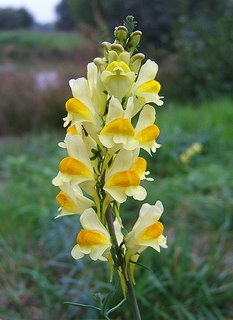Until a year ago I don't think I could identify a single wildflower other than a dandelion. Butter-and-eggs (Common Toadflax) is among one of the first I learned on that eye opening day at Hoffman Park with Patrick. From the Figwort family, the perennial alien butter-and-eggs is commonly found during summer months but has a long life from about June through October. Its name comes from the rich yellow and orange colors that look very much like butter and egg yolks. This coloring made it an easy first flower for me to remember. I did a little research and found out what makes it thrive.
Butter-and-eggs flowers need outside help for pollination and bees love to lend a hand. Bumblebees are the most common pollinators of butter-and-eggs because they have long tongues that can reach into the long, narrow reservoir of the flower. However, other bees have figured out how to get in. The yolk colored spot serves as a landing pad for the bee. When the bee lands on the "yolk", the weight opens the spur, allowing access to the nectar. Another strategy bees have learned is to land on the top of the flower and climb in upside down. You can see pictures of a honey bee climbing in using various techniques
here.
A common threat to butter-and-eggs is
seedpod weevils, which can deposit their eggs in the flower ovaries. The larvae then feed on the seeds, thus preventing procreation. Other threats include the
common buckeye butterfly,
toadflax brocade moth caterpillar,
twice-stabbed stink bugs, and
tree hoppers, which all feed on the foliage while the weevil,
Mecinus janthinus, attacks the stem and shoots. Although butter-and-eggs have all these natural control agents it is still a fairly hearty plant due to its easy seed distribution and adaptability (it can survive fires and herbicides). Butter-and-eggs thrives in sandy and rocky soil and is commonly found in fields, waste areas and roadsides. It is native to Europe but is found almost globally now.
As for breakfast, butter-and-eggs is said to have been used as a laxative and a diuretic but I wouldn't suggest tasting it. It has a strong, stinky odor that is sure to make you lose your appetite fast. That must be why the stink bugs love it. I'll stick to my store-bought butter and eggs.

Butter-and-eggs
Photographed by
Squeezyboy and posted on
Flikr















